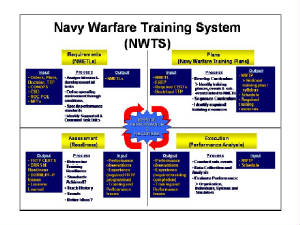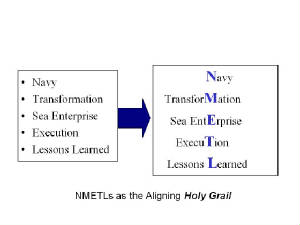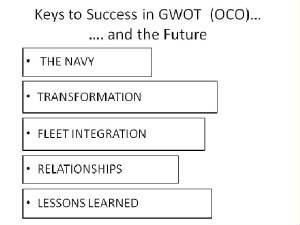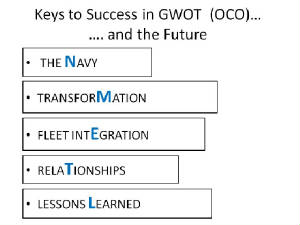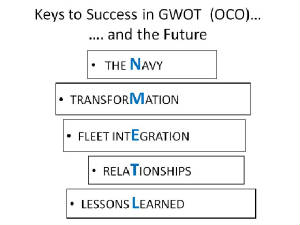|
|
Seven Steps Toward NMETL Advocacy A Systems Thinking Approach for Fleet Integration David K. Brown The NMETL Advocate Navy Warfare Development Command 25 April 2011
When Admiral Mullen took over as CNO in July 2005, he directed Commander, U.S. Fleet Forces (USFF) to conduct a “strategic review” that, among other products, would produce “NMETLS” for emerging missions and capabilities, which include standards compatible with joint readiness reporting requirements.[1] – “What?”
What exactly is an NMETL and where did they come from? A Navy Mission-Essential Task List (NMETL) is a comprehensive command and mission specific list of Navy Mission-Essential Tasks (NMETs). More Jominian in concept, but demanding of the Clauswitzian Coup d’oeil in application, “NMETLs allow a commander to quantify the level and scope of effort required to achieve mission objectives.”[2] From a War College perspective, the “METL” actually is a “Nature of War vs Character and Conduct of War” principle.[3] System encompassing NMETLs clearly state mission requirements on which all continuous improvement processes can focus. Navy Leaders responsible for alignment, setting expectations, driving continuous improvement, and incorporating lessons learned and best practices, should understand the NMETL concept and its applications to our quest for “Cost-wise” readiness.
CNO Guidance In December 2005, the CNO message entitled “Anchoring Sea Enterprise”[4] listed five key fundamentals for sustained efficiency and effectiveness: 1. Senior leaders must drive transformation by setting aligned expectations. 2. Leaders must create a continuous improvement culture by defining and measuring outputs, balancing risks and ensuring accountability. 3. Navy-wide alignment of organizations and processes must share best practices, leverage core competencies, and become more efficient and effective. 4. All must embrace best practices and employ lessons learned in a continuous improvement process. 5. All must develop “business acumen.” Leaders must become knowledgeable about the systems and processes leading to greater efficiency and effectiveness. This message also stated five steps in the Way Ahead for success in Sea Enterprise: 1. Know your business. 2. Dig into your processes. 3. Focus on efficient delivery of value. 4. Create a culture of innovation. 5. Capture savings.
Further, in CNO Guidance for 2007, he exclaimed, “Focus on “Execution!”[5] Admiral Harvey enjoined as he took over U.S. Fleet Forces in July 2009: “Be brilliant on the basics. Maintain Standards!” and I heard him say: “Focus on the Funda-METLs.” To those who know, the concept of mission analysis and the system of Navy Mission-Essential Task Lists (NMETLs) embodied in the Navy Warfare Training System, cover and align all of the fundamentals of Sea Enterprise and include the five steps for sustained success. NMETLs can be the “aligning” Holy Grail!
DOD Transformation can be visualized as running on a four-phased “continuous improvement engine” fueled by lessons learned (Figure 1). DOD Transformation’s website described it thusly: “Transformation is foremost a continuing process that does not have an end point. It is meant to create or anticipate the future…. The overall objective of these changes is simply – sustained American competitive advantage in warfare.” 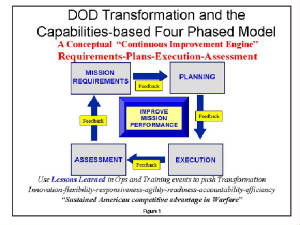 The Defense Readiness Reporting System[7] and all new joint capabilities require METLs or MET-like descriptions for expressing mission performance requirements. The Navy Warfare Training System (NWTS) employs NMETLs as the basis for fleet training programs. However, NMETLs are considerately more applicable, comprehensive, and enlightening than just being used for Fleet training!
Linking Integrated
Operations to the GPRA The strategy-to-task mission analysis process described in the UJTL reflects a growing understanding of the new, wider definition of jointness (now "integrated") and offers a pathway for the executive branch’s combined response to meet the requirements of the Government Performance Results Act (GPRA) of 1993. Congress enacted the GPRA to solve perceived problems with the federal government’s performance and accountability. Designed to improve the American people’s confidence in their government, the GPRA established strategic planning and performance measurement across all departments. The GPRA systematically holds Federal agencies accountable for achieving program results. The GPRA specified that Executive Branch entities would Set program goals, Measure program performance against those goals, and Report publicly on their progress. The combined effects should be to raise the accountability and promote the efficiency and effectiveness of the federal government. Many think-tanks and leaders began to develop systems to track and display progress such as Balanced Scorecards and “Dashboards.” The METL process reflects a proven method to fill in the sections of these new tools to meet GPRA as well as align integrated mission performance requirements and pursue evidenced-based management! That will really lead to “One Team, One Fight!”
Proceeding on Seven Steps Navy leaders must become “NMETL Advocates” by following the seven-step
method outlined in the following chart:
Conclusion Mission-focused NMETLs and the NWTS are universally applicable to driving continuous improvement and applying evidenced-based practices. NMETL Advocacy can be simple and fun! Understand the background and the framework for METLs. Learn the mission analysis and systems thinking process. Drive for the standard. Appreciate conditions. Practice critically and creatively. Grow your confidence in your “coup d’oeil” and apply NMETLs-based systems thinking routinely and innovatively for success.
ALIGNMENT
The focus is on improving mission performance through defining,
measuring, and analyzing task performance. This process helps you visualize mission accomplishment, value every contribution, verify mission progress, and validate the approach. Because it is a continuous process, the NMETL may be refined
during the continuous mission analysis phase as assessments direct. Note each phase includes inputs, processes, and outputs
and is set up for LEAN-SIX SIGMA applications! This is truly a simplified application of the late Colonel John Boyd’s
“O-O-D-A” process! The “Navy Readiness Enterprise System”A conceptual “Navy Readiness Enterprise System” (NRES) based on the NWTS process provides a systematic approach to full mission accomplishment and sustained mission readiness that identifies mission-based capability needs in the requirements phase; identifies and codifies prioritized DOTMLPF-P and operating requirements in various planning documents in the planning phase; conducts and evaluates program execution based on METL (cost-effective and efficient) focused metrics in the execution phase; and gathers and analyzes the collective results- including Best Practices and Lessons Learned- of Naval operations, production and training in the assessment phase. DOTMLPF-P enhancements can be developed out of Assessment phase products– all focused on improved mission performance: “Better-cheaper-faster” – Capabilities – maintenance, training, accountability-operations-test and experiments. Every element of the Sea Enterprise can build its specific NMETL to set performance and see and continuously update how its results affects others’ mission accomplishment. |
||||||||||||||||||||||||||||||||||||||||||||||||
Enter supporting content here

